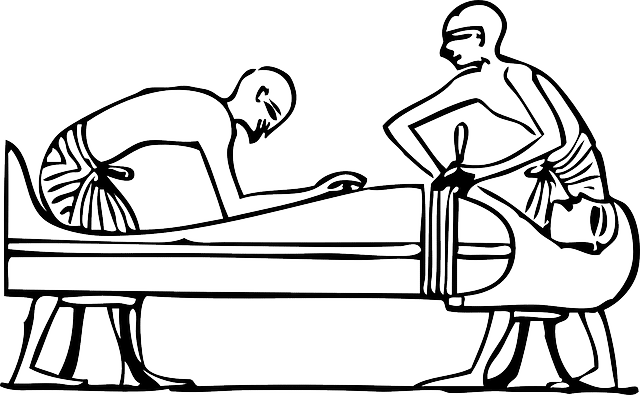
The Afterlife, Part 1: Buried Costs
Published by Anne Altor on Jan 25th 2021
The Cycle of Life.
 The Afterlife, Part 1. The dark days of winter (in the midst of a pandemic) seem like an apropos time to reflect on life and death. In some ways, reflecting on death can help us keep a perspective on life and appreciate each day, moment, breath.
The Afterlife, Part 1. The dark days of winter (in the midst of a pandemic) seem like an apropos time to reflect on life and death. In some ways, reflecting on death can help us keep a perspective on life and appreciate each day, moment, breath.
Being committed to a sustainable lifestyle means also thinking about what happens to our bodies after we die. The goal of this post isn't to tackle questions of the soul, but to consider typical ways the body is handled after death. We can create a plan that ensures we embody our values in death as well as life.
Life on Earth depends on death and decomposition, the continual recycling of organic and mineral matter from one life into another. The elements we're made of have circulated through the planet since Earth's beginning – we really are stardust! When we die, our biomass gets released back into the Earth to be reborn into new life. That is, if our bodies aren't embalmed or cremated and locked away in a treated casket.
In this post we'll look at what's involved in standard post-life procedures in industrialized society. In Part 2, we discuss natural burial options that enable us to give back to the Earth and continue to be a part of natural cycles after we pass on. We provide guidance for how to plan a green burial in Part 3 of this series. Read on to learn more about embalming, cremation, and the high (ecological) cost of caskets.
Embalming.
 In the U.S., the Civil War catalyzed the development of the embalming industry. Thousands of soldiers were dying far from home, and families who could afford it would have their young men sent home for burial. Bodies began to decompose before trains could get them home, and this led to adoption of embalming techniques. President Lincoln sanctioned embalming for all Union troops and was embalmed himself after his assassination.
In the U.S., the Civil War catalyzed the development of the embalming industry. Thousands of soldiers were dying far from home, and families who could afford it would have their young men sent home for burial. Bodies began to decompose before trains could get them home, and this led to adoption of embalming techniques. President Lincoln sanctioned embalming for all Union troops and was embalmed himself after his assassination.
The goal of embalming is to slow down decomposition, often so an open-casket funeral can take place some time after death. Embalming fluid enmeshes with organic matter and denatures the body's proteins, making them indigestible to bacteria. About 1 gallon of embalming fluid (formaldehyde mixed with methanol) is used per 50 pounds of body weight. The steps of embalming include propping or gluing the eyes closed, sewing the jaw shut, and replacing blood and lymph with chemicals. Formaldehyde, the most-used embalming fluid (and a carcinogen), is pumped into the veins while blood is drained out. Then, the hollow body organs (stomach, bladder, large intestines, lungs, and other hollow organs) are punctured and drained, and more embalming fluid is pumped into the torso through small puncture holes. More than five million gallons of embalming fluid are used each year in the US alone. When the casket eventually breaks down and the body is exposed to soil and water, the toxic embalming fluid seeps into the ground, polluting the environment.
Cremation.
 During cremation, the body is burned at high temperature and reduced to its mineral elements. After removing pacemakers, jewelry etc., the body is placed in a casket or other burnable container and moved into the cremation temperature where it's combusted at 1400–2000℉ for up to 3 hours. According to cremationresource.org, "the heat dries the body, burns the skin and hair, contracts and chars the muscles, vaporizes the soft tissues, and calcifies the bones so that they eventually crumble." The gases released during cremation are discharged through an exhaust system. The Guardian found that cremation requires "about 285 kiloWatt hours of gas and 15kWh of electricity on average per cremation – roughly the same domestic energy demands as a single person for an entire month."
During cremation, the body is burned at high temperature and reduced to its mineral elements. After removing pacemakers, jewelry etc., the body is placed in a casket or other burnable container and moved into the cremation temperature where it's combusted at 1400–2000℉ for up to 3 hours. According to cremationresource.org, "the heat dries the body, burns the skin and hair, contracts and chars the muscles, vaporizes the soft tissues, and calcifies the bones so that they eventually crumble." The gases released during cremation are discharged through an exhaust system. The Guardian found that cremation requires "about 285 kiloWatt hours of gas and 15kWh of electricity on average per cremation – roughly the same domestic energy demands as a single person for an entire month."
After combustion, the remains are ground down to sand-sized particles, any remaining metal is removed, and the ashes are placed in an urn or box to return to the family. The body does not need to be embalmed before cremation. There's an alternative method called "liquid cremation," which uses a strong base such as potassium hydroxide, heat and pressure to break down the body. This "green cremation" technique uses much less energy than traditional cremation, but it's not as widely available and so far is only legal in 20 states. Regardless of the method used, the cremation process burns away the nutrients and organic matter that would otherwise nourish the Earth through decomposition.
Caskets and Burial Vaults.
 Typical caskets are made of wood or metal with a fabric lining and weigh 200+ pounds. In the U.S., some 30 million board feet of wood go into caskets every year. I used Penn State Extension forestry statistics to calculate that this represents about 6000 acres (~9 square miles) of mature forest per year. Steel caskets are also common; ~100,000 tons of steel are buried each year in the U.S. in caskets and burial vaults.
Typical caskets are made of wood or metal with a fabric lining and weigh 200+ pounds. In the U.S., some 30 million board feet of wood go into caskets every year. I used Penn State Extension forestry statistics to calculate that this represents about 6000 acres (~9 square miles) of mature forest per year. Steel caskets are also common; ~100,000 tons of steel are buried each year in the U.S. in caskets and burial vaults.
The casket may be placed in a burial vault–a sealed enclosure that further walls off the body's return to Nature. According to overnightcaskets.com,"Without a vault, a casket cannot withstand the earth's load for long." Some graveyards require people to be buried in vaults to help keep the ground around the casket from caving in. Burial vaults are made of plastic, metal or concrete and add another 400 to 3000 pounds to the apparatus. In 2009, over 1.5 million tons of reinforced concrete was buried in vaults in the U.S. alone.
Impacts of Conventional Burial Practices in the U.S.
The impacts of embalming, cremation and burial in caskets and vaults are huge and flow from a cultural denial that humans are a part of Nature. A hugely profitable industry has grown up around death–a matter that traditionally was handled by the family without a big expense. The annual impacts of industrialized afterlife practices in the U.S. include:
? Hundreds of thousands of gallons of toxic embalming fluid pumped into bodies and placed in the ground
? Over 500 pounds of CO2 released per high-temperature cremation
? Destruction of forests and mining of metals for caskets and burial vaults: well over 1 million caskets are sold in the U.S. every year, not including casket containers used for cremations.
? Unsustainable land use. Cemetery space is limited, especially in urban areas. Preserving our dead bodies in underground vaults replaces ecosystems with toxic chemical catacombs and denies the Earth much needed organic matter. The average human body contains ~54 pounds of organic materials, all borrowed from the Earth.
? Cemeteries can provide above-ground habitat and green oases in urban areas, especially if they're allowed to be wild rather than mowed, "modernized," maintained in turf grass and sprayed with herbicides. Older cemeteries populated with native trees and plants, and often having varied topography, can provide especially good habitat. But cemeteries fill up and people keep dying. By going to elaborate means to avoid and delay decay, humans create a huge environmental burden and keep this borrowed material locked out of the cycles of life and regeneration.
See The Afterlife: Sustainable Dying to learn about natural burial options that honor regenerative values.

Image by PIRO4D from Pixabay
